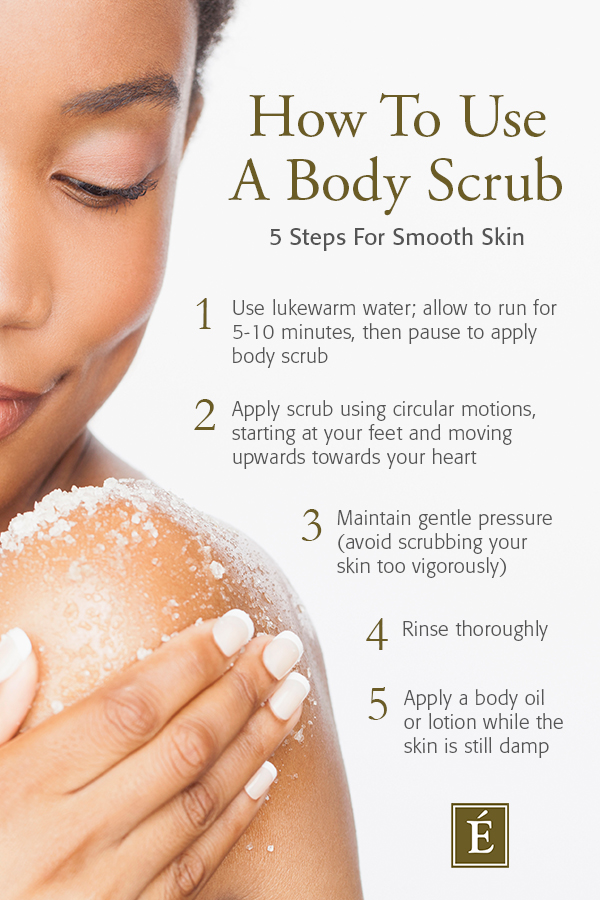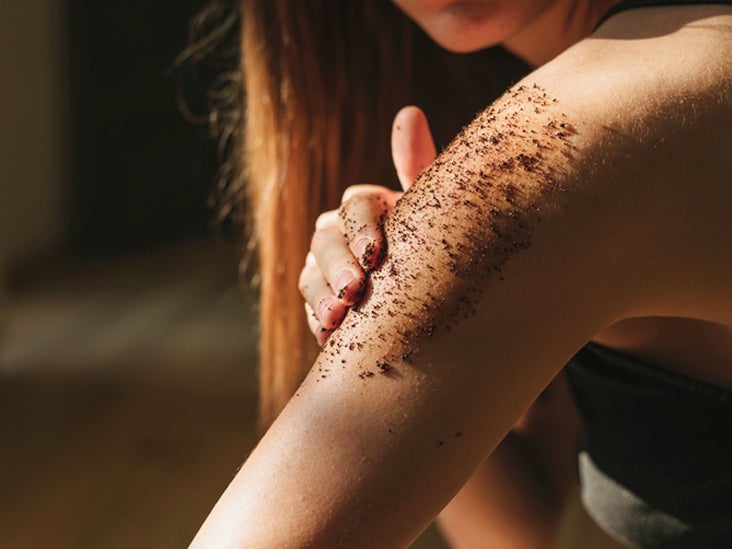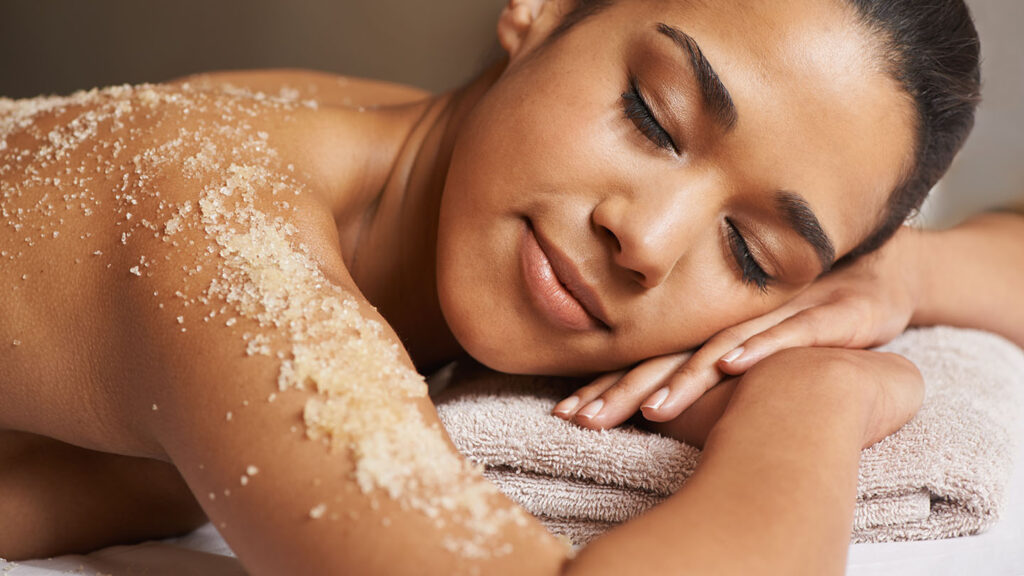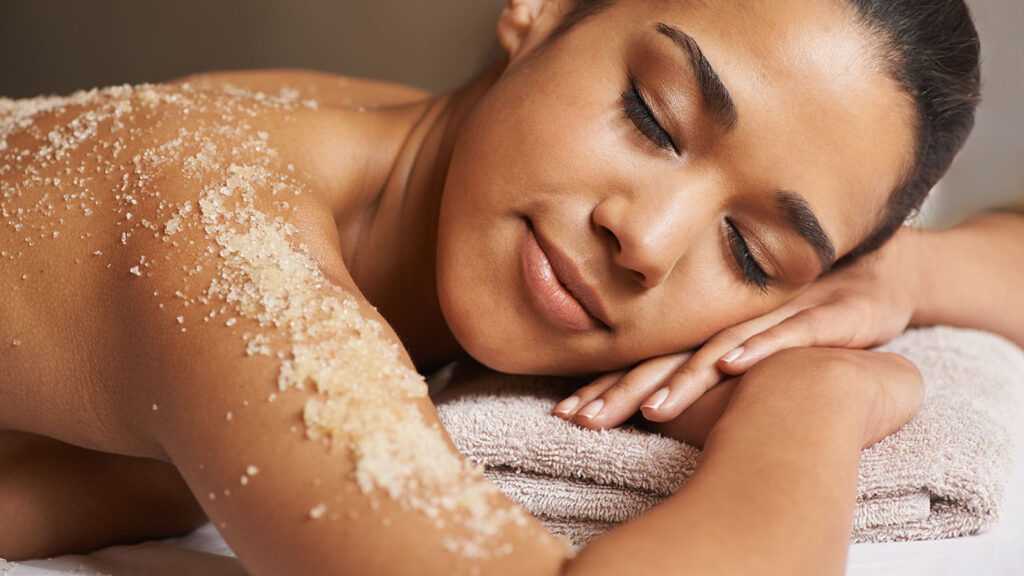Are you curious about body exfoliation? Look no further! Centre of Wellness has the answers you’re seeking. Body exfoliation is a technique that involves removing dead skin cells from the surface of your skin to reveal a smoother, more radiant complexion. It not only improves the appearance of your skin but also allows for better absorption of moisturizers and treatments. If you’re interested in learning more about body exfoliation and how it can benefit you, visit the Beauty Training Courses at https://beautytrainingcoursesonline.com/courses-overview/. Take the first step towards achieving healthier, glowing skin today!

This image is property of eminenceorganics.com.
What is Body Exfoliation?
Body exfoliation refers to the process of removing dead skin cells from the surface of your body. Dead skin cells can accumulate over time, leaving your skin looking dull, dry, and rough. By exfoliating regularly, you can help rejuvenate your skin, promote cell turnover, and achieve a smoother and healthier complexion.
Exfoliation can be done using various techniques and products, including mechanical exfoliation, chemical exfoliation, and enzyme exfoliation. Each method offers unique benefits and is suitable for different skin types and concerns. By understanding the different types of body exfoliation and choosing the right techniques for your needs, you can achieve optimal results and maintain a radiant and youthful appearance.
Benefits of Body Exfoliation
Removes dead skin cells
One of the primary benefits of body exfoliation is the removal of dead skin cells. As new skin cells are continuously produced, the old ones can accumulate on the surface, leading to a dull and lackluster appearance. By exfoliating regularly, you can slough off these dead skin cells, revealing the fresh, new cells underneath. This not only improves the overall texture of your skin but also allows for better absorption of moisturizers and other skincare products.
Improves skin texture
Exfoliating your body regularly can help improve the texture of your skin. By removing dead skin cells, you encourage the growth of new cells, resulting in a smoother and softer complexion. This can be particularly beneficial for areas prone to roughness, such as elbows, knees, and heels. Regular exfoliation can also minimize the appearance of rough patches and help your skin feel more even and refined.
Reduces ingrown hairs
If you struggle with ingrown hairs, body exfoliation can be a game-changer. Ingrown hairs occur when hair follicles become trapped beneath the surface of the skin, leading to irritation and inflammation. By exfoliating regularly, you can help prevent the buildup of dead skin cells around hair follicles, reducing the risk of ingrown hairs. This is particularly important for areas that are frequently shaved or waxed, such as the legs, underarms, and bikini line.
Enhances skin radiance
Exfoliating your body can also enhance the radiance and glow of your skin. By removing the outer layer of dead skin cells, you reveal the fresh and luminous skin underneath. This can make your complexion appear brighter and more youthful. Regular exfoliation can also stimulate blood circulation, which can contribute to a healthy and vibrant appearance. Whether you want to achieve a natural glow or prepare your skin for a special occasion, body exfoliation can be a valuable addition to your skincare routine.
Different Types of Body Exfoliation
When it comes to body exfoliation, there are various techniques you can choose from, depending on your preferences and skincare needs. The three main types of body exfoliation are mechanical, chemical, and enzyme exfoliation. Each technique offers unique benefits and caters to different skin types and concerns.
Mechanical exfoliation
Mechanical exfoliation involves physically scrubbing or brushing the skin to remove dead skin cells. This can be done using different tools and products, such as dry brushes, exfoliating gloves, loofahs, body scrubs, and exfoliating body brushes. Mechanical exfoliation is effective in sloughing off dead skin cells and stimulating blood circulation. It can be particularly beneficial for those with rough or dry skin.
Chemical exfoliation
Chemical exfoliation involves using products that contain specific acids or enzymes to dissolve dead skin cells. The two main types of acids used in chemical exfoliation are alpha hydroxy acids (AHAs) and beta hydroxy acids (BHAs). AHAs, such as glycolic acid and lactic acid, work by gently loosening and removing dead skin cells from the surface. BHAs, such as salicylic acid, are oil-soluble and can penetrate deeper into the pores, making them effective for treating acne and clogged pores. Chemical exfoliation can be a suitable option for those with sensitive skin or those looking for a more targeted approach.
Enzyme exfoliation
Enzyme exfoliation involves using natural enzymes, typically derived from fruits, to dissolve dead skin cells. The most common enzymes used in skincare products are papaya enzyme and pineapple enzyme. These enzymes work by breaking down the proteins that hold dead skin cells together, allowing them to be easily removed. Enzyme exfoliation is often recommended for sensitive skin types as it provides a gentle and non-abrasive exfoliation.
Mechanical Exfoliation Techniques
Dry brushing
Dry brushing involves using a natural bristle brush on dry skin to remove dead skin cells and stimulate blood circulation. To dry brush, start at your feet and brush in upward circular motions towards your heart. Dry brushing can help improve lymphatic drainage, reduce the appearance of cellulite, and exfoliate the skin. It is important to use a brush with soft bristles and to brush gently to avoid irritating the skin.
Loofah
A loofah is a natural sponge that can be used to exfoliate the body. It is made from the fibrous interior of a gourd-like vegetable. Wet the loofah and apply a gentle cleanser or body scrub. Gently massage the loofah over your skin in circular motions, focusing on areas that are prone to roughness or dryness. Rinse the loofah well after each use and allow it to dry completely to prevent bacteria growth.
Exfoliating gloves
Exfoliating gloves are gloves made from a textured fabric that helps scrub away dead skin cells. Wet the gloves and apply a small amount of body wash or scrub. Gently massage your skin using circular motions, paying extra attention to areas that need more exfoliation. Rinse the gloves well after each use and hang them to dry.
Body scrubs
Body scrubs are products that contain exfoliating particles suspended in a moisturizing base. They often feature ingredients such as sugar, salt, or coffee grounds for exfoliation and oils or butters for hydration. Apply a generous amount of body scrub to damp skin and massage it in circular motions. Rinse off the scrub thoroughly and pat your skin dry.
Exfoliating body brushes
Exfoliating body brushes typically have natural bristles and a long handle to reach all areas of the body. Use the brush on dry skin before showering or bathing. Brush your skin using upward circular motions, starting from your feet and working your way up. Pay extra attention to areas like elbows, knees, and the back. After brushing, shower or bathe as usual to remove any loosened skin cells.

This image is property of www.aveeno.com.
Chemical Exfoliation Techniques
AHAs (Alpha Hydroxy Acids)
Alpha hydroxy acids (AHAs) are water-soluble acids that help exfoliate the skin by dissolving dead skin cells. The most commonly used AHAs in skincare products are glycolic acid and lactic acid. These acids work by loosening the bonds that hold dead skin cells to the surface, revealing a smoother and brighter complexion. AHAs are suitable for various skin types, but those with sensitive skin may need to start with lower concentrations and gradually build up their tolerance.
BHAs (Beta Hydroxy Acids)
Beta hydroxy acids (BHAs) are oil-soluble acids that can penetrate deep into the pores, making them effective for treating acne and clogged pores. The most commonly used BHA in skincare products is salicylic acid. BHAs work by exfoliating the inside of the pores, reducing inflammation, and preventing the formation of new blemishes. They are particularly beneficial for oily and acne-prone skin types.
Retinol
retinol is a derivative of vitamin A and is highly regarded for its exfoliating and anti-aging properties. It helps stimulate cell turnover, unclog pores, and reduce the appearance of fine lines and wrinkles. Retinol is available in various strengths, from over-the-counter formulations to prescription-strength products. It is important to introduce retinol gradually into your skincare routine to avoid irritation and to use sunscreen during the day as retinol can increase sun sensitivity.
Enzyme Exfoliation Techniques
Papaya enzyme
Papaya enzyme is derived from the papaya fruit and is known for its gentle exfoliating properties. It contains an enzyme called papain, which helps break down dead skin cells and promote a brighter complexion. Papaya enzyme is often used in facial masks and exfoliating cleansers. Apply a papaya enzyme product to clean, damp skin and leave it on for the recommended time, usually a few minutes. Rinse off with warm water and follow with moisturizer.
Pineapple enzyme
Pineapple enzyme, also known as bromelain, is derived from pineapple and offers similar exfoliating benefits as papaya enzyme. It helps remove dead skin cells, reduce inflammation, and improve overall skin texture. Pineapple enzyme is commonly found in facial masks, peels, and exfoliating cleansers. Apply the product to clean, damp skin and leave it on for the recommended time. Rinse off thoroughly and follow with moisturizer.

This image is property of post.healthline.com.
Choosing the Right Exfoliant for Your Skin Type
When choosing an exfoliant for your body, it is important to consider your skin type and specific concerns. Different exfoliation techniques and products are suited to different skin types and can yield different results. Here are some guidelines to help you choose the right exfoliant for your skin:
Dry skin
If you have dry skin, you may want to opt for gentle exfoliation methods and products that offer hydration. Avoid harsh scrubbing and opt for products with moisturizing ingredients like shea butter, coconut oil, or hyaluronic acid. Chemical exfoliation with AHAs or enzyme exfoliation can also be beneficial for dry skin as they gently remove dead skin cells without stripping the skin of its natural oils.
Oily skin
If you have oily or acne-prone skin, exfoliation can help remove excess oil, unclog pores, and prevent breakouts. Mechanical exfoliation methods like body scrubs and exfoliating gloves can be effective in physically removing dead skin cells and dirt from the surface. Chemical exfoliation with BHAs, such as salicylic acid, can penetrate the pores and help control oil production. Be cautious not to over-exfoliate, as this can lead to dryness and irritation.
Sensitive skin
For sensitive skin, it is important to choose exfoliation methods and products that are gentle and non-irritating. Enzyme exfoliation with papaya or pineapple enzymes is often well-tolerated by sensitive skin types. Look for products labeled as gentle or suitable for sensitive skin. It is also advisable to perform a patch test before using a new exfoliant on your entire body to ensure that you do not experience any adverse reactions.
Combination skin
If you have combination skin, different areas of your body may have different needs. It can be beneficial to adjust your exfoliation routine accordingly. Focus on using lighter exfoliation methods and products on drier areas and consider incorporating stronger exfoliants, like BHAs or AHAs, on oilier areas to address clogged pores and breakouts. It may require some experimentation to find the right balance for your specific skin concerns.
Frequency of Body Exfoliation
The frequency of body exfoliation depends on several factors, including your skin type, the chosen exfoliation method, and your skin’s tolerance. Here are some general guidelines for exfoliating your body:
Daily
Exfoliating your body daily is generally not recommended, as it can lead to over-exfoliation and irritation. Daily exfoliation is more suitable for very oily skin types or for specific areas that need extra attention, such as rough elbows or knees. If you prefer daily exfoliation, opt for gentle methods like dry brushing or light chemical exfoliation.
Weekly
Most people find that exfoliating their body once or twice a week is sufficient. This frequency allows for the removal of dead skin cells without causing excessive dryness or irritation. Choose a convenient day and time to incorporate exfoliation into your regular skincare routine. Remember to adjust the frequency based on your skin’s response and needs.
Bi-weekly
For those with sensitive skin or those new to exfoliation, exfoliating every two weeks can be a good starting point. This allows your skin to acclimate to the exfoliation process and reduces the risk of over-exfoliation. As you become more comfortable with exfoliating, you can gradually increase the frequency to once a week or as needed.

This image is property of goodspaguide.co.uk.
Precautions and Safety Measures
While body exfoliation can offer numerous benefits, it is essential to be mindful of the following precautions and safety measures to ensure optimal results and maintain skin health:
Avoid over-exfoliation
Over-exfoliating can lead to skin irritation, dryness, and increased sensitivity. It is important to listen to your skin and adjust the frequency and intensity of exfoliation accordingly. If your skin becomes red, inflamed, or excessively dry after exfoliation, it is a sign of over-exfoliation. Give your skin a break and allow it to recover before exfoliating again.
Patch test
Before trying a new exfoliant or product, it is always advisable to perform a patch test. Apply a small amount of the product to a discreet area of your body, such as the inner arm or behind the ear, and wait 24 hours to observe for any adverse reactions. If you experience redness, itching, or inflammation, it may indicate an allergic reaction, and you should avoid using the product.
Consult a dermatologist if necessary
If you have specific skin conditions, such as eczema, psoriasis, or acne, or if you are unsure about the right exfoliation technique for your skin, it is recommended to consult a dermatologist. They can assess your skin’s needs and provide personalized recommendations for safe and effective exfoliation.
DIY Body Exfoliation Recipes
If you prefer a more natural and homemade approach to body exfoliation, here are some simple DIY recipes you can try:
Coffee and coconut oil scrub
Ingredients:
- 1/2 cup of coffee grounds
- 1/4 cup of coconut oil
Instructions:
- Mix the coffee grounds and coconut oil in a bowl until well combined.
- Apply the mixture to damp skin and gently massage in circular motions.
- Rinse off thoroughly with warm water and pat your skin dry.
- Follow with a moisturizer to seal in hydration.
Brown sugar and honey scrub
Ingredients:
- 1/2 cup of brown sugar
- 2 tablespoons of honey
- 2 tablespoons of olive oil
Instructions:
- Combine the brown sugar, honey, and olive oil in a bowl.
- Massage the mixture onto damp skin, focusing on areas that need exfoliation.
- Rinse off with warm water and pat your skin dry.
- Moisturize your skin to keep it hydrated and soft.
Oatmeal and yogurt mask
Ingredients:
- 1/4 cup of ground oatmeal
- 2 tablespoons of plain yogurt
- 1 tablespoon of honey
Instructions:
- Mix the ground oatmeal, yogurt, and honey in a bowl to form a paste.
- Apply the mask to clean, damp skin and leave it on for 10-15 minutes.
- Rinse off with warm water and gently pat your skin dry.
- Apply a moisturizer to nourish and hydrate your skin.
These DIY recipes are gentle and suitable for most skin types. However, if you have specific allergies or sensitivities, it is advisable to test the ingredients on a small area of your skin before applying them to your entire body.
In conclusion, body exfoliation is a valuable skincare practice that offers numerous benefits. Whether you choose mechanical, chemical, or enzyme exfoliation, there are various techniques and products available to suit your preferences and skin type. By incorporating regular exfoliation into your skincare routine and choosing the right exfoliant for your needs, you can achieve smoother, healthier, and more radiant skin. Remember to exfoliate in moderation, conduct patch tests for new products, and seek professional advice if necessary. With consistent and appropriate exfoliation, you can enjoy the transformative effects that body exfoliation can bring to your overall skin health and appearance.


